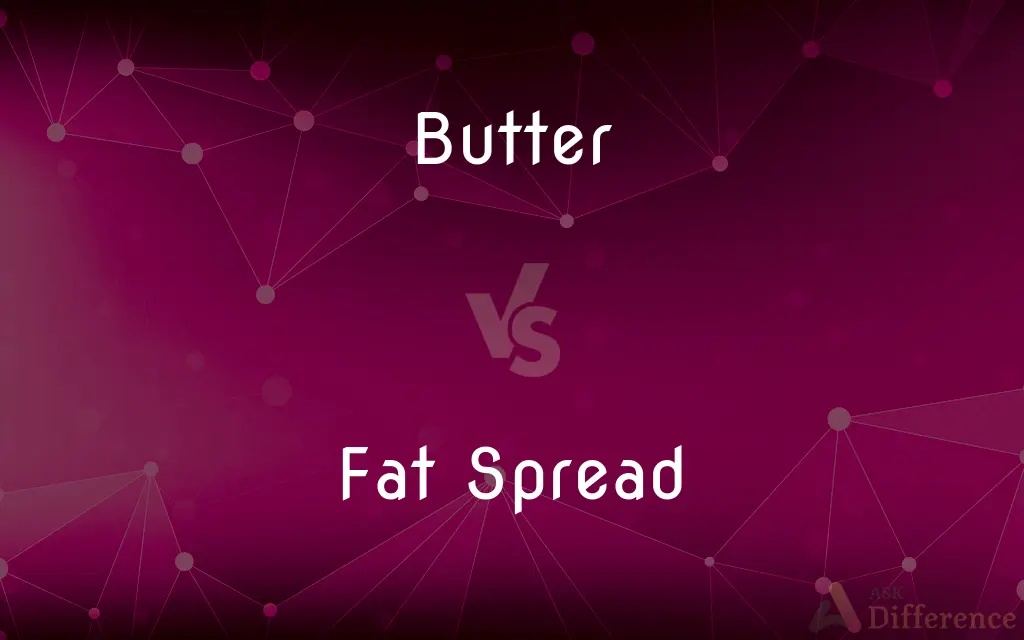Butter vs. Fat Spread — What's the Difference?
By Tayyaba Rehman — Published on January 25, 2024
Butter is a dairy product made from churned cream, rich in saturated fats, while fat spread is a blend of vegetable oils and other ingredients, often with lower saturated fat content.

Difference Between Butter and Fat Spread
Table of Contents
ADVERTISEMENT
Key Differences
Butter is a natural dairy product created by churning cream until it solidifies. This process separates the butterfat from the buttermilk, resulting in a product that is typically about 80% fat. Fat Spreads, on the other hand, are manufactured products usually made from a blend of vegetable oils and may include other ingredients like water, emulsifiers, and sometimes dairy components. They can vary widely in fat content, often designed to be lower in saturated fat compared to butter.
The flavor of Butter is distinct and rich, often described as creamy and slightly sweet. It's a popular choice for cooking and baking due to its unique flavor and ability to enhance the taste of other ingredients. Fat Spreads are engineered to mimic the taste and texture of butter but can vary in flavor depending on the ingredients used, and are often less rich than real butter.
In terms of nutrition, Butter is high in saturated fats and contains cholesterol, contributing to its rich taste and texture. Fat Spreads are typically formulated to have lower levels of saturated fats, often containing unsaturated fats like those found in vegetable oils, making them a preferred option for those managing cholesterol levels.
Butter is generally used in recipes where its distinct flavor is desired, such as in pastries, sauces, and as a spread. Fat Spreads are often used as a direct substitute for butter as a spread or in cooking, but may behave differently in baking due to their different compositions.
Butter requires refrigeration to maintain its solidity and freshness, while Fat Spreads, depending on their composition, can often be stored at room temperature without spoiling as quickly. This difference affects their texture and ease of spreading.
ADVERTISEMENT
Comparison Chart
Base Ingredient
Dairy (Cream)
Vegetable oils
Fat Content
High in saturated fats
Varies, often lower in saturated fats
Flavor
Rich and creamy
Mimics butter, less rich
Usage
Cooking, baking, spreading
Spreading, cooking, variant in baking
Storage
Requires refrigeration
Often room temperature stable
Compare with Definitions
Butter
A dairy product made from churned cream.
I used butter to make the cookie dough richer.
Fat Spread
Often stable at room temperature.
The fat spread spreads easily straight from the pantry.
Butter
High in saturated fats and creamy in texture.
The butter gave the sauce a smooth and rich finish.
Fat Spread
Often lower in saturated fats than butter.
I chose fat spread to reduce my saturated fat intake.
Butter
Popular in baking for its unique flavor.
Butter is essential for making flaky pie crusts.
Fat Spread
Can be used as a butter substitute in cooking.
I substituted butter with fat spread in the recipe.
Butter
Known for its distinct, slightly sweet flavor.
The fresh bread tastes even better with some melted butter.
Fat Spread
Engineered to mimic butter's taste and texture.
The fat spread was surprisingly similar to butter in flavor.
Butter
Requires refrigeration to maintain freshness.
Store the butter in the fridge to keep it solid.
Fat Spread
A blend of vegetable oils and other ingredients.
I used fat spread on my toast this morning.
Butter
A soft yellowish or whitish emulsion of butterfat, water, air, and sometimes salt, churned from milk or cream and processed for use in cooking and as a food.
Butter
A spread made from fruit, nuts, or other foods
Plum butter.
Cashew butter.
Butter
A vegetable fat having a nearly solid consistency at ordinary temperatures.
Butter
Flattery.
Butter
To put butter on or in.
Butter
A soft, fatty foodstuff made by churning the cream of milk (generally cow's milk).
Butter
Any of various foodstuffs made from other foods or oils, similar in consistency to, eaten like or intended as a substitute for butter (preceded by the name of the food used to make it).
Peanut butter
Soy butter
Chocolate butter
Butter
Any of various substances made from other (especially plant-based) oils or fats, used in moisturizers, cosmetics, etc.
Butter
Any specific soft substance.
Butter of antimony; butter of arsenic
Butter
A smooth plane landing.
Butter
Someone who butts, or who butts in.
Butter
(transitive) To spread butter on.
Butter the toast.
Butter
To move one's weight backwards or forwards onto the tips or tails of one's skis or snowboard so only the tip or tail is in contact with the snow. Similar to applying butter to bread with then end of a butterknife.
Butter
To spin on skis or a snowboard using only the tips or tails being in contact with the snow
Butter
To increase (stakes) at every throw of dice, or every game.
Butter
Very smooth, very soft
That landing was total butter!
Butter
An oily, unctuous substance obtained from cream or milk by churning.
Butter
Any substance resembling butter in degree of consistence, or other qualities, especially, in old chemistry, the chlorides, as butter of antimony, sesquichloride of antimony; also, certain concrete fat oils remaining nearly solid at ordinary temperatures, as butter of cacao, vegetable butter, shea butter.
Butter
One who, or that which, butts.
Butter
To cover or spread with butter.
I know what's what. I know on which sideMy bread is buttered.
Butter
To increase, as stakes, at every throw or every game.
Butter
An edible emulsion of fat globules made by churning milk or cream; for cooking and table use
Butter
A fighter who strikes the opponent with his head
Butter
Spread butter on;
Butter bread
Common Curiosities
Can fat spread be used for baking like butter?
Yes, but it may affect the texture and flavor of baked goods differently than butter.
Why is butter so flavorful?
Butter's rich taste comes from its dairy base and high fat content.
What is a fat spread?
Fat spread is a manufactured product mainly made from vegetable oils, designed to mimic butter.
What is butter?
Butter is a natural product made from churning cream, rich in saturated fats.
Do fat spreads have cholesterol?
Most fat spreads made from vegetable oils do not contain cholesterol.
Can I store butter at room temperature?
It's not recommended as it can spoil; butter should be refrigerated.
Does butter contain trans fats?
Natural butter does not contain trans fats; however, some processed butters might.
Is butter considered healthier than fat spread?
Butter is natural but high in saturated fats, while fat spreads can be formulated to be healthier with lower saturated fats.
Are fat spreads more processed than butter?
Yes, they typically undergo more processing to combine various ingredients.
Are all fat spreads vegan?
Not necessarily; some may contain dairy ingredients, so it's important to check the label.
Is butter good for frying?
Butter can be used for frying, but it has a lower smoke point compared to some fat spreads.
Which is better for heart health – butter or fat spread?
Generally, fat spreads with unsaturated fats are better for heart health than butter.
Is it healthier to cook with butter or fat spread?
It depends on the specific dietary needs, but fat spreads lower in saturated fats are often considered a healthier option for cooking.
What makes butter solid in the fridge?
The high saturated fat content in butter solidifies at cooler temperatures.
Can I use fat spread on toast instead of butter?
Yes, fat spreads are commonly used as a spread on toast.
Share Your Discovery

Previous Comparison
International Airport vs. Intercontinental Airport
Next Comparison
Solar Cell vs. LEDAuthor Spotlight
Written by
Tayyaba RehmanTayyaba Rehman is a distinguished writer, currently serving as a primary contributor to askdifference.com. As a researcher in semantics and etymology, Tayyaba's passion for the complexity of languages and their distinctions has found a perfect home on the platform. Tayyaba delves into the intricacies of language, distinguishing between commonly confused words and phrases, thereby providing clarity for readers worldwide.












































